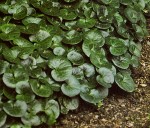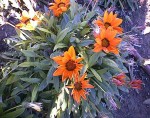Every gardener uses groundcovers in their landscapes even if they do not realize it. Often times groundcovers are overlooked, simply taken for granted as the green stuff growing on the hillside. When we do get around to discussing groundcovers, the first thing that pops into our minds are low spreading ivy, vinca minor, spreading junipers, and ajuga that we planted to hide something bad.
Ask a lawn maintenance company in our local to name a ground cover and he will state without hesitation “Kentucky Blue Grass.” Personally, I think groundcovers are any plant used to protect the soil by forming a dense protective blanket, if it is attractive so much the better.
Well just what then is a groundcover and what does it do! The Melbourne Water District defines groundcover plants as:
“Goundcovers are tough, prostrate-growing plants that can help retain soil moisture, keep soil cool and suppress weeds.”
While the Virgina Extension Service describes groundcover as:
“Groundcovers are low-growing plants that spread quickly to form a dense cover. Grass is the best known ground cover,but grass is not suited to all locations.”
Usually ground cover plants are utilized for, steep banks, shady areas under trees, under plantings in shrub borders and beds, where tree roots grow close to the surface and prevent grass from growing, and very wet or dry locations.
Groundcovers not only solve problems but also unify different components in the landscape. A low groundcover can provide a transition between the lawn and taller plants used in beds. They soften hardscapes such as walks, steps, and driveways.
What plants you use are based on the conditions of the site and on what you like. The groundcovers you choose should require only minimal care. They should be able to depend mainly on the rainfall for nourishment. An annual application of fertilizer may be given, but not necessary, to keep the plants growing vigourously. Selected plantings should only be divided if they cease to grow well through overcrowding. The most common mistake made by the home gardener is in not using enough plants in the initial planting to adequately cover the area. Please do not skimp in this area to save money, it will only give you years of grief.
Groundcovers are merely another gardening tool, one when correctly used will, save you time and money, while adding to the overall beauty of your landscape. Choose your planting wisely and they will provide years of carefree charm. Do not be afraid to experiment with different plants, all groundcover does not need to look like English Ivy.
Tips of the Month
The following are our favorite plants for use as groundcovers:

Asarum europaeum ‘European Ginger’
This little creeper gives off a strong scent of ginger from its large fleshy tubers. Though it can be situated in borders, it comes into its own as a ground-core plant in moist and shady parts of the garden. The flowers are a deep red but even more important are the silky leaves.

Gazania rigens
This is a perennial grown as an annual that grows well in rock gardens or in other hot, dry areas. It forms a very low, ground-hugging ground cover, producing bright yellow, orange or red, daisy-like flowers. Flowers close at night and on very cloudy days. Plants grow 6 to 12-inches tall with blueish foliage. Do not plant in the partial shade as a full day’s sun is required for healthy plants.

Epimedium grandflorum ‘Tama No Genpei’
It emerges in spring with attractive purple tinted foliage. Epimediums will never be the traffic stoppers like roses, but these perennials are the unsung workhorses that tie the woodland garden together. Epimediums are easy to grow, tenacious perennials that provide a welcome first breath of spring with their airy flowers, then a solid backdrop of attractive foliage for the remainder of the growing season.

Juniperus procumbens ‘Nana’
This dwarf juniper is especially good for groundcover or cascading over walls with its tight growth habit and bright green foliage. One of the most sought after low growing junipers with a very interesting growing habit. The very best of the low growing junipers.

Lavandula angustifoliia ‘Hidcote ‘
This is one of the most versatile herbs, inspiring poets, gardeners, artists, cooks and healers for hundreds of years. The scent of lavender has long been linked with romance, as Shakespeare’s writings exemplify. Aromatic, evergreen greyish foliage.

Dennstaedtia punctilobula ‘Hay Scented Fern’
This is native to eastern North America is a popular garden fern being very adaptable and tolerant of many conditions. Fronds: lanceolate 3-5″ wide, twice to tri-pinnate, pinnae toothed with irregularly cut margins or teeth, scattered hairs on rachis and stipe
Flower of the Month

Polygonatum odoratum thunbergii Variegatum -Variegated Japanese Solomon’s Seal
This is graceful shade plants that provide nice form and structure to the garden. These plants have long arching unbranched stems, they have nice clean, veined leaves with clusters of bell like greenish yellow to whitish yellow flowers hanging down from the stems at the leaf axis. In late summer and fall showy berries are produced that are blue to dark blue in color.
The rhizomes of Solomon seals are white, long, thick and somewhat knobby, they usually grow about 2-4 inches underground in a horizontal angle to the surface. Most Solomon seals grow in spreading colonies that are easy to dig up and divide.
Web Site of the Month
Collector’s Nursery is a retail mail order nursery with an interest in unique plant material. They specialize in dwarf and rare conifers and uncommon, choice perennials, with a strong emphasis on shade plants. Collector’s also have a wide offering of variegated plants, and an expanding selection of rare trees and shrubs. We propagate almost all of our own material from our large display garden. Some of our favorite genera are Epimedium, Tricyrtis, Corydalis, and Arisaema.



